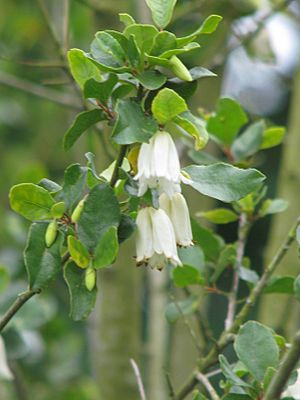Patagua facts for kids
Quick facts for kids Patagua |
|
|---|---|
 |
|
| Scientific classification | |
| Genus: |
Crinodendron
|
| Species: |
patagua
|
The patagua (also known as the lily of the valley tree) is a beautiful evergreen tree that grows in Chile. You can find it in wet areas and ravines, often high up in the mountains, sometimes as high as 1,200 meters (about 4,000 feet) above sea level. This tree can grow quite tall, reaching up to 10 meters (about 33 feet).
The patagua tree has simple, oblong leaves with a saw-toothed edge. It produces lovely white flowers that look like bells, with five petals. When the fruit ripens, it's an orange-colored capsule.
According to old Chilean stories, the patagua tree came from women who were sad about their past actions and asked for help. Instead of disappearing, they were changed into trees. This is why some people say patagua trees sometimes look like human figures.
Contents
Growing and Using the Patagua Tree
The patagua tree is useful in many ways!
Honey Production
Its flowers are great for making honey. Bees love the patagua, and it helps them produce delicious honey.
Leather and Furniture
The bark of the patagua tree contains something called tannin. This is used to treat leather, making it strong and durable. The wood from the patagua tree is also used to make furniture.
Planting and Care
The patagua tree is easy to grow, which makes it good for planting new forests. You can plant it from seeds, and it grows very quickly. It can even handle cold weather and frosts.
People have successfully planted the patagua tree as an ornamental plant (meaning it's grown for its beauty) in places like New Zealand, California, Northern Ireland, Scotland, Wales, and parts of England. However, it doesn't always flower as much in the United Kingdom as another similar tree, Crinodendron hookerianum, which has red or pink flowers.
What's in a Name?
The name Crinodendron comes from Greek words meaning "lily tree." The name "patagua" comes from the Mapuche language, which is spoken by Indigenous people in Chile.
See also
 In Spanish: Patagua para niños
In Spanish: Patagua para niños

